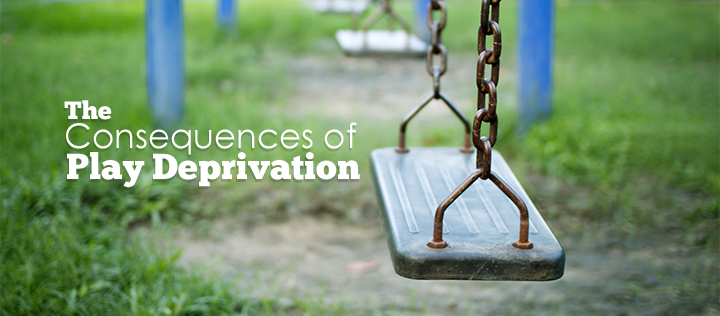The Consequences of Play Deprivation

The first assignment we give to children is to learn how to play. Play time can be independent activities such as building blocks, reading, or creative activities such as painting and crafts. It can also involve group participation games with peers, which teach them how to negotiate, compromise, communicate, and enjoy the social company of others.
To suggest that nowadays many children are deprived of play time may seem impossible to fathom. After all, playing is what kids do best, and they do it innately, with very little stimulation from parents and caregivers. Kids want to play, so how could the modern child possibly be deprived of playtime? For adults the idea may not make much sense. But it is a real problem that psychologists and sociologists are looking at as they evaluate the impact of our busy world on the free play time available for kids.
No Time to Waste
The stresses of a global economy and the increased focus on academic performance for American children have resulted in a de-emphasis on play. No one likes to hear that, compared to other countries like Japan, our children study less, learn at a slower rate, and are less successful in fields such as science and math. The literacy rate in Japan, for instance, is 99%, whereas adults in the United States ranked 21st out of 23 other industrial nations in mathematics and literacy.
Officials that collected the data inferred that children in the United States needed more homework and less play time. Modelling their suggestions after some other countries who have achieved higher academic results with longer study hours, this became the emphasis for revamped curriculums for kids.
In fact as a parent, have you noticed that children get far more homework than you used to get as a child? It’s not your imagination; it’s a fact that American kids in middle school have more homework than children in other developed nations—including Japan—although according to some studies, it has not increased the level of academic performance or scores for kids. See “Do Kids Have Too Much Homework” via the Smithsonian website.
With decreased academic performance and increased obesity, stress, and symptoms of anxiety in American children, childhood educators are now asking if the reduction in playtime has had a negative impact on the overall development of children.
Is Playtime a Waste of Time?
What happens when a child plays—either inside or outdoors—is key to healthy development. In most of their daily activities, whether at school or home, children are discouraged from the “non-essential” in their schedule; in other words, away from play. They are over supervised in most cases, leaving little to no room for self-direction, independent learning, or exploration. There are measurable consequences that can be observed when children are deprived of play.
All creatures in nature are prone to play in their infancy and adolescence. In “The Archaeology of the Mind” by Jaak Panksepp, the author discusses research that demonstrates the impact of deficits in play on the healthy socialization and physical development of mammals.
“Current research suggests that the PLAY system may be especially important in the epigenetic development and maturation of the neocortex… the universal recognition of every child’s need to play may help shape wise social and educational policies in the future.”
“The burgeoning evidence from the basic science of play behavior as revealed through careful play manipulations does however, [reveal] patters not before seen, and pints to the capacity of play to foster greater adaptive capacities, not seen in the play deprived.”
A review of such research concludes that not only do children suffer from a lack of life engagement, creative expression, diminished optimism and energy, but adults do as well. That means that play time is an important attribute for the wellness of human beings at any age, and perhaps some of the persistent problems or deficits we see in physical fitness, emotional wellness, and social involvement stem from a deprivation of fun and playtime in our schedules, from childhood to adulthood.
Creative Play Activities
For children, creative or exploratory play opportunities must be incorporated into their daily schedule to avoid a play deficit and promote engaged learning, self-expression, and social development. For children under 12 years of age, these activities can include:
- Riding a bike on trails or at the local playground
- Painting or crafts (indoor or outdoor)
- Hiking and nature walks, bird watching, etc.
- Playing with a group of children at a local playground
- Building boats or experimenting with sand or water
- Scientific or environmental experiments that are fun
- Supervised cooking or baking activities
- Building a fort from safe materials (with adult supervision)
- Team sports or athletic activities, and more


